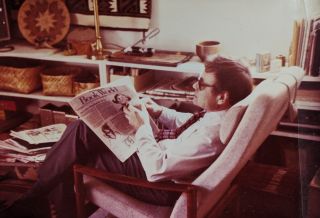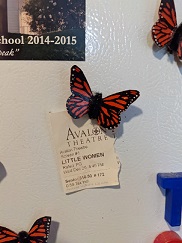My father’s favorite reading chair endures across the generations.

My father’s reading chair is a classic of mass-market, Midcentury Modern Scandinavian design. You know this chair: teak, with spare wooden legs and armrests and a high, straight back. Settle in to read, lean back, and the chair reclines — well, jolts you backward and pops your feet up. It came with a footrest and a small detachable head-rest pillow (filled with something as soft as uncooked rice). The upholstery choices were rough-weave fabric in neutral tones. Mom went for oatmeal.
The chair had its place in our family room, a small, multipurpose space open to the galley kitchen. Dad sat in the chair, watching the news and reading the paper. An insomniac, he’d also spend some of the wee hours of most nights in the chair with a paperback mystery, sipping Ovaltine or Postum. When my brother and I were teenagers, Dad wasn’t exactly waiting up for us to come in, but he was always up — a built-in security system and deterrent.
I’ve done the math. By my estimate, over the course of close to 40 years, he logged about 30,000 hours in the chair before my parents moved to a retirement community. The chair and footrest (beanbag pillow long gone) came, too, making their generic living room feel like home.
A couple years later, my parents died. Dad’s chair and footrest came home with us, landing first in my husband’s study, later moving down to the basement to join a dilapidated futon, bookshelves full of paperbacks and board games, a ping-pong table, and giant spiders and crickets. The chair saw hard duty on snow days and during slumber parties. In three blinks, the kids were gone. The chair, like the ping-pong table, fell into disuse.
A few more blinks, and son Tim was furnishing his apartment. The chair left the basement for a room with a view. Footrest and chair parted company; my elderly aunt needed to elevate her feet while reading in her own smaller Midcentury Modern armchair. In the eventual flurry of downsizing when she died, both her chair and the footrest went to the retirement-community thrift shop (not the first and not the last of my downsizing mistakes, but that’s another story).
Tim traded up for a sectional sofa. Our daughter Rebecca was moving to Baltimore; he gifted her the chair. Blink, blink: Rebecca moved to New Haven. Blink again: She moved to New Orleans. Both times, the chair squeezed into the U-Haul.
My parents never rearranged furniture. Age and geographic relocations took a toll on the chair, accustomed as it was to a quiet, stationary life. Approaching 60 years old, springs shot, its threadbare beige birthday suit didn’t work in the Big Easy. Rebecca had it re-sprung, re-stuffed, and reupholstered in a rich burnt orange. Almost pretty enough to be a throne for a Mardi Gras float; quite the makeover! And more comfortable than ever before.
Blink: Rebecca moved north to Washington, with chair. Blink again: she flew to Sweden for a few years. The chair was too big for carry-on, and besides, she’d have IKEA.
Meanwhile, my husband, Harry, and I had downsized, pared our furniture quite a bit. Still, the chair was irresistible; we took it on as long-term live storage. It looked right at home lodged in a corner of the den against a brilliant green wall painted by the prior owner (dubious at first, we’ve come to love the bold wall color). Chartreuse wall, orange chair — an homage to Peter Max.
Like my father, I’m an insomniac. The chair became my mid-night reading perch, though I skipped the Postum. But it was just a loaner. Flash-forward four years. We welcomed Rebecca back to Washington and said farewell to the chair. The former reading corner was so bare and empty.
Our kids make good use of online used-furniture marketplaces. Just for the heck of it, I searched for “midcentury modern recliner.” Bingo! Beginner’s luck: the chair (and bonus footrest). The price wasn’t just right, it was a bargain, perhaps because the upholstery was an eye-popping green. Harry and I took a leap of faith that it wouldn’t clash and drove across town.
The chair and footrest lived up to the profile picture. I told the seller my story; he knocked off $50 and promised to find another footrest for my daughter (still waiting). But it was very, very green, and it’s not easy being green, as Kermit the Frog knows. Peter Max is one thing, the Emerald City quite another. Oh, well. Worst-case scenario, we’d move to New Orleans and get it reupholstered.
My husband squeezed the chair into the Prius, knowing from experience exactly how to angle it to fit. We drove home. He carried the chair; I followed with the footrest. Moment of suspense! Afternoon light streamed in the window. Think of all the shades of green in a spring forest; green on green is glorious.
Our bright green chair practically glows at night. An ensconced insomniac might not need a reading light.
Ellen Prentiss Campbell’s collection of love stories is Known By Heart. Her story collection Contents Under Pressure was nominated for the National Book Award, and her debut novel, The Bowl with Gold Seams, won the Indy Excellence Award for Historical Fiction. Her novel Frieda’s Song was a finalist for the Next Generation Indie Book Award, Historical Fiction. Her column, “Girl Writing,” appears in the Independent bi-monthly. For many years, Campbell practiced psychotherapy. She lives in Washington, DC, and is at work on another novel.

